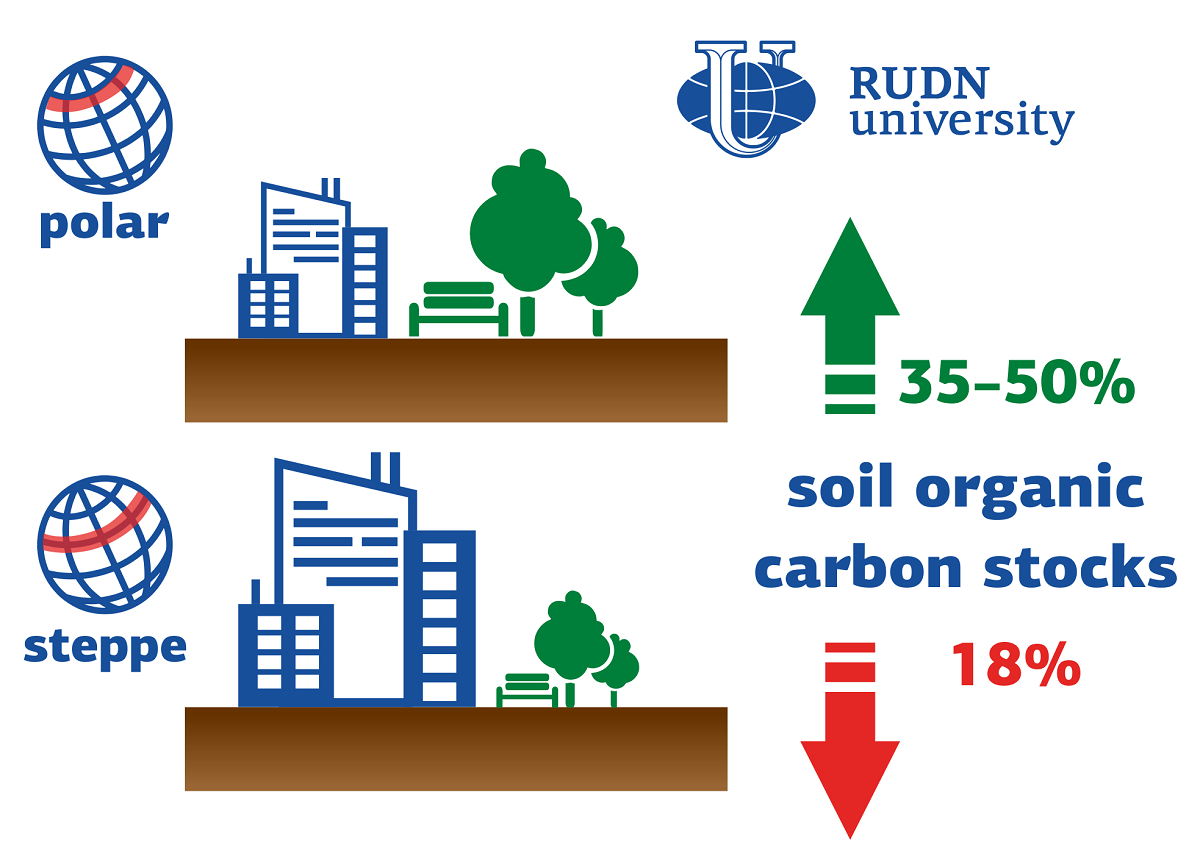RUDN scientists found out how development the cities influence carbon stocks in soils of steppes and Subpolar zone Russian Federation

The impact of urbanisation on the environment has become one of the major environmental issues of the 21st century. Urban development is changing the soil cover of areas: on the one hand, it is being sealed off, ’sealed’ under a layer of asphalt or buildings. On the other hand, artificial green spaces are being created, the soils under which are being fertilised. This affects the stock of organic carbon in the soil, which determines its fertility, sustainability and the variety of micro-organisms that inhabit it. Soils covered with asphalt, for example, contain far less organic carbon than natural soils, while lawns and urban green spaces, due to irrigation and fertilisation, contain more.
In addition, the amount of organic carbon depends on the climate: in hot and arid areas, this element is mineralized faster and becomes inaccessible to soil inhabitants. Scientists from the RUDN have studied the impact of urbanisation on changes in organic carbon stocks in the soils of Murmansk and Rostov-on-Don. The comparison of these cities made it possible to determine that the urban environment affects soil properties differently in different climatic regions of Russia.
“The European part of Russia is very diverse in terms of vegetation and soil conditions: from tundra with podzolic soils in the north to steppes with chernozems in the south. In addition, it is home to about 55% of the total population of our country, so the problem of urbanisation is very relevant. The two cities chosen for the study — Murmansk and Rostov-on-Don, give a good idea of all the diversity of climate, soils and vegetation in European Russia,” says Yuri Dvornikov, PhD, from the RUDN Institute of Agricultural Technology.
“In addition, about 55% of the total population of our country live here, so the problem of urbanisation seems very relevant. The two cities chosen for the study — Murmansk and Rostov-on-Don — give a good idea of all the diversity of climate, soils and vegetation in European Russia,” says Yuri Dvornikov, PhD in Geology and Mineralogy, from the RUDN Agrarian and Technological Institute.
First, the researchers determined the baseline organic carbon stocks in the selected regions before the cities were built. For this purpose, they used databases and digital soil maps of Russia. The scientists compared the carbon stock data with satellite maps of Murmansk and Rostov-on-Don. The land cover within the cities was divided into six types: closed surface (asphalt or buildings), water bodies, bare soil, tree green spaces, shrubs, and lawns. Changes that occurred to soils after the construction of the cities were assessed using literature descriptions of the urban soils of Murmansk and Rostov-on-Don.
About 18% of the soil in Murmansk was found to be covered in asphalt or under buildings, with the highest percentage of “sealed” areas being in the seaport area, city centre and industrial area. Green areas occupied 58% of the area, with trees and shrubs predominating in the vegetation cover. Such urban planning resulted in a 38% increase in organic carbon stock in the surface soil layer (up to 10 cm from the surface) and a 50% increase in the deeper layers (up to 1 m) compared to the original soils before the construction of the city. In Rostov-on-Don a very different situation was observed: 28% of soils were “sealed”, while lawns and tree green spaces occupied only 23% and 15% of the city territory respectively. Under these conditions, urbanization reduced organic C stocks in the topsoil by 18%, but increased those in the deeper layers by 21%. Overall, the researchers estimated that the average soil C stocks in Rostov-on-Don were 40% lower than in Murmansk.
“The resulting differences can be explained by two factors. The first is different urban planning. For example, in Murmansk landscaping, peat and peat-peat mixtures, which are rich in organic carbon, are additionally applied to the soils, which contributes to the enrichment of this component. In Rostov-on-Don, local soils are used in green areas, so there is no enrichment. The second factor is the climatic differences between the cities. In Murmansk, located in the north, soils are slower to mineralize, and the stock of organic carbon appears more stable than in the south of Russia. The data we have obtained will help us consider the climatic features of different regions when planning urban development to avoid depletion of local soils,” Yuri Dvornikov concluded.
The project to develop a cellular model of the placenta became the winner in the Scientific Materials category of the Young Scientists 3.0 competition, organized with the support of the Presidential Grants Foundation and T-Bank.
Ten scientific journals published by RUDN University have been included in the highest level of the state list of scientific publications, the White List.
Forests are not only the lungs of the planet, but also home to millions of species. However, it has remained unclear how underground interactions between trees and fungi affect forest species richness in different climatic conditions. Previous studies have yielded conflicting results: in some regions, the dominance of certain fungi reduced tree diversity, while in others it increased it.
The project to develop a cellular model of the placenta became the winner in the Scientific Materials category of the Young Scientists 3.0 competition, organized with the support of the Presidential Grants Foundation and T-Bank.
Ten scientific journals published by RUDN University have been included in the highest level of the state list of scientific publications, the White List.
Forests are not only the lungs of the planet, but also home to millions of species. However, it has remained unclear how underground interactions between trees and fungi affect forest species richness in different climatic conditions. Previous studies have yielded conflicting results: in some regions, the dominance of certain fungi reduced tree diversity, while in others it increased it.